
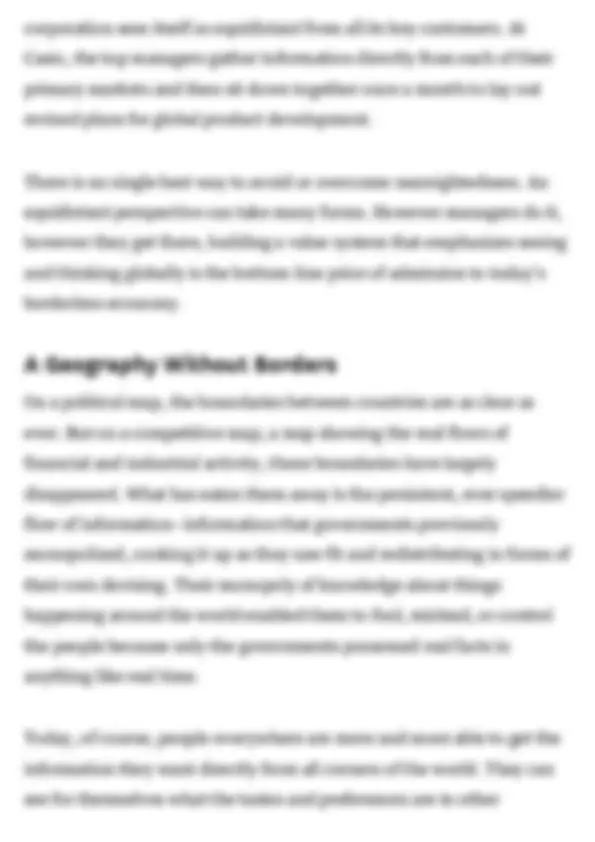



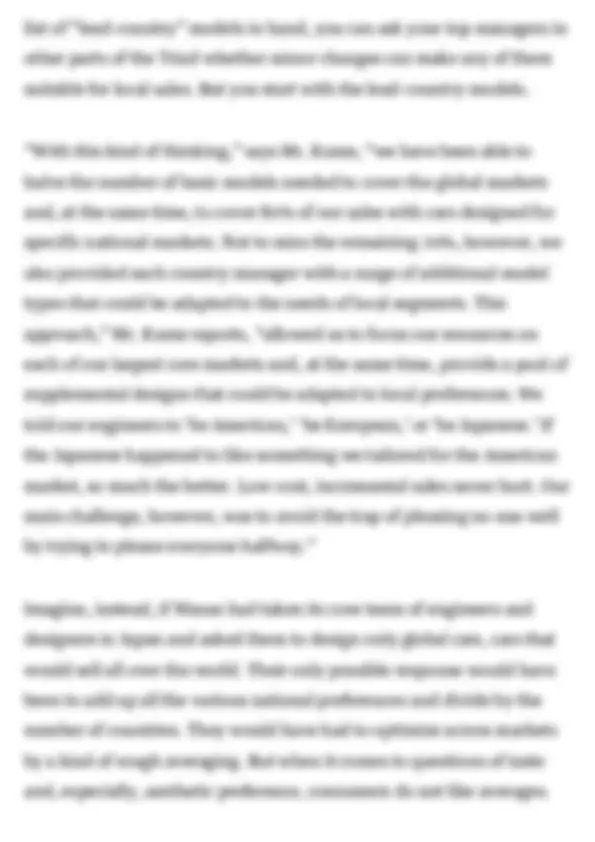
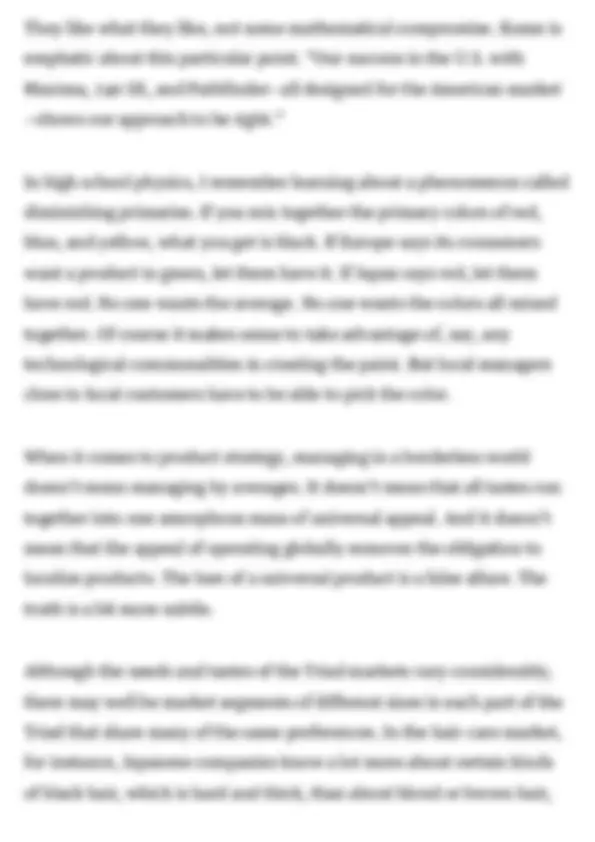
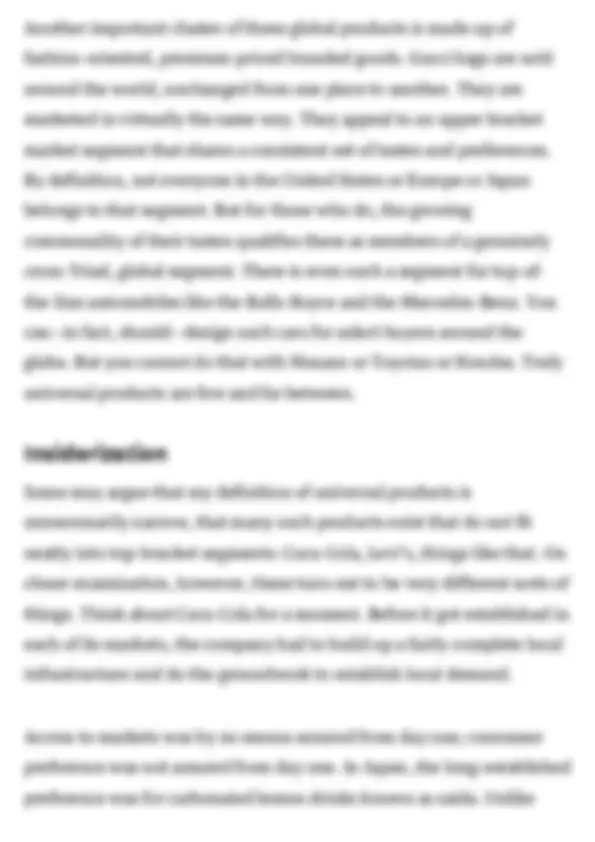


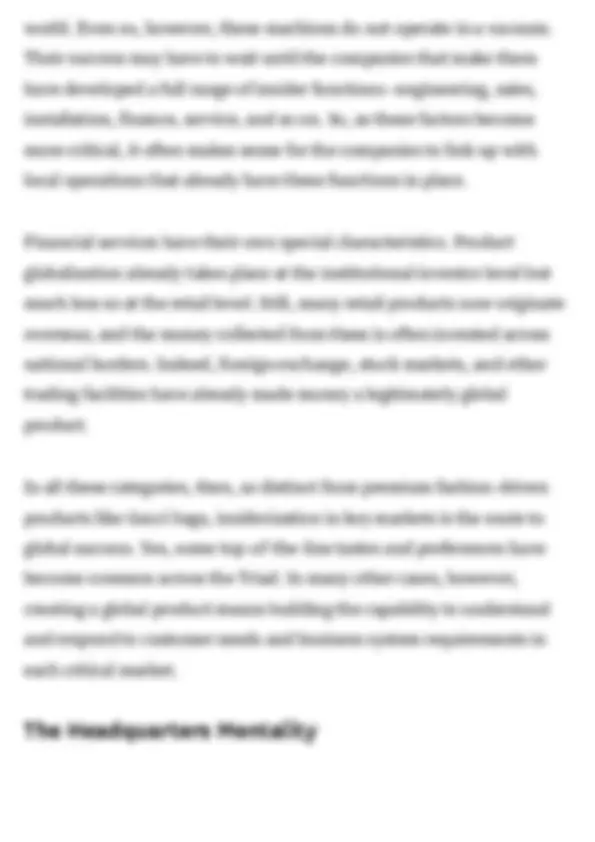
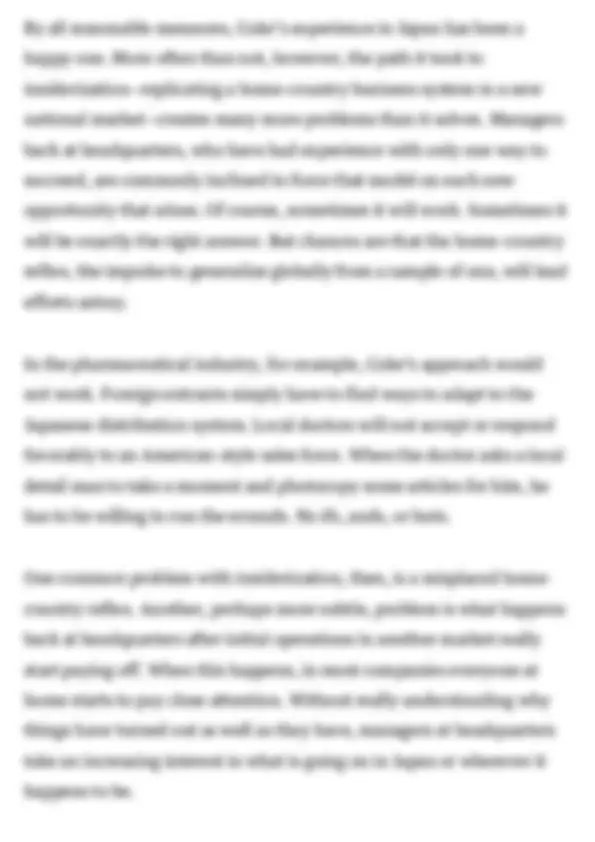

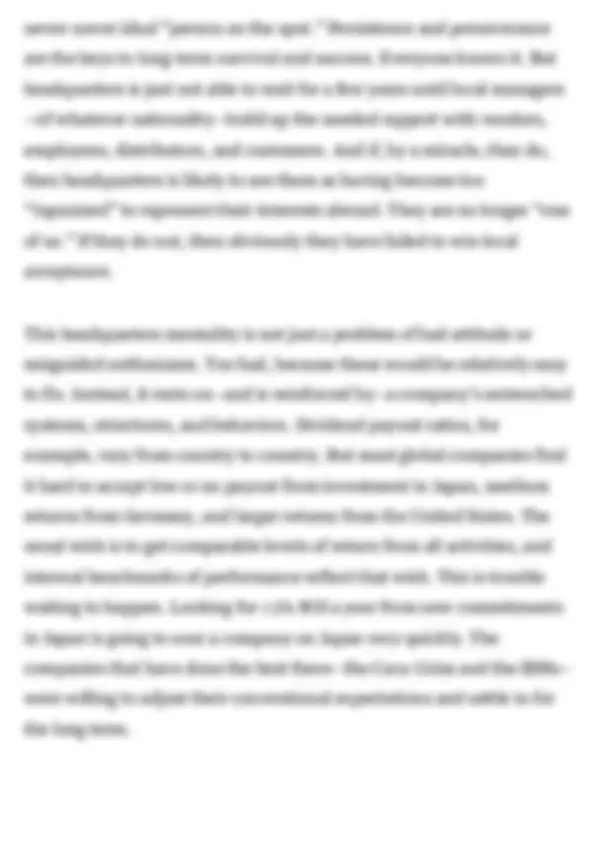

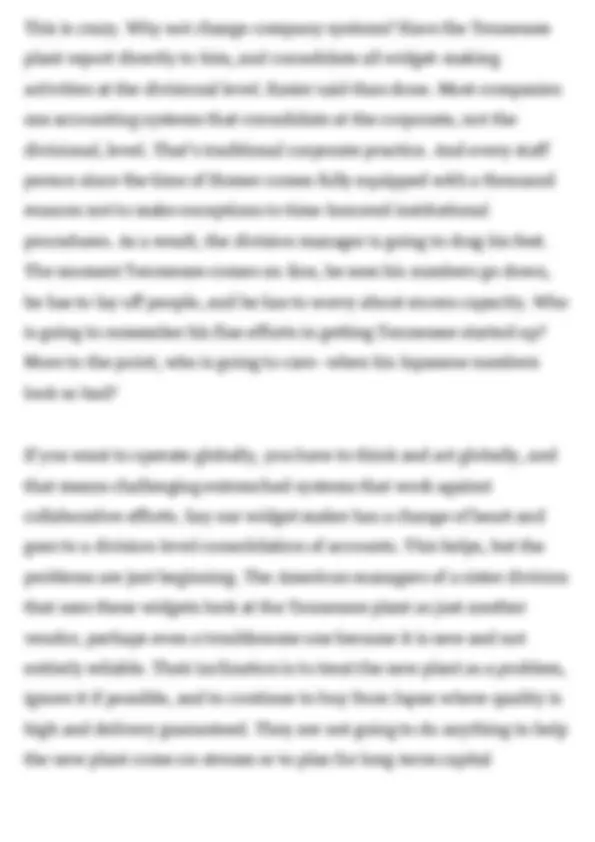
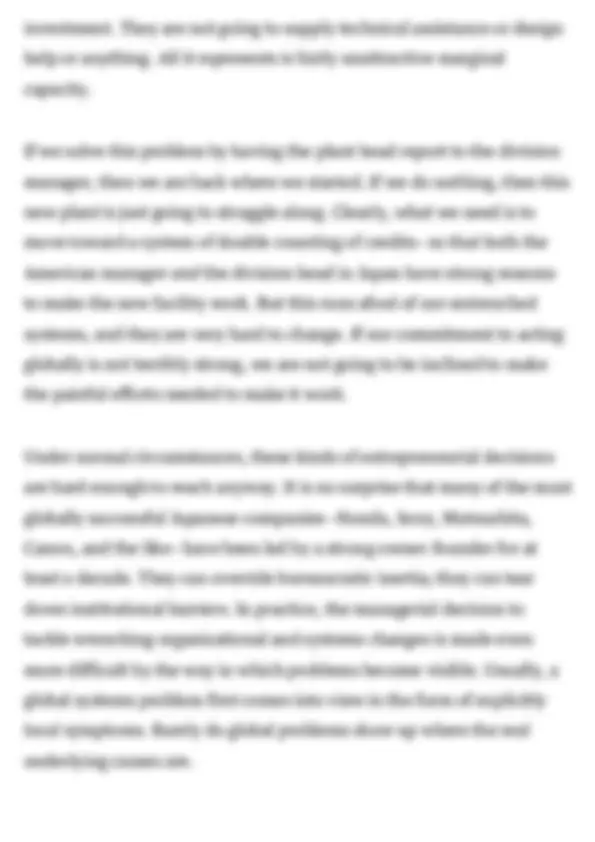
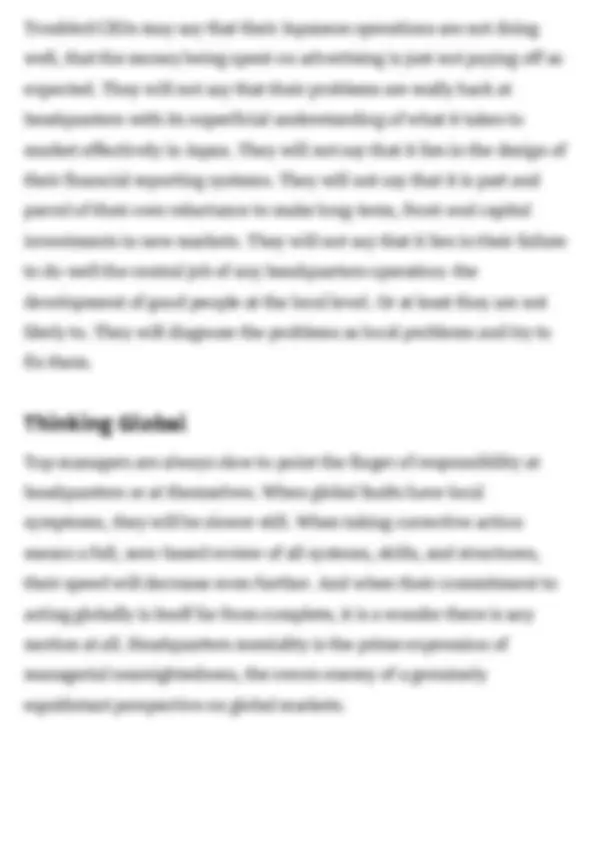
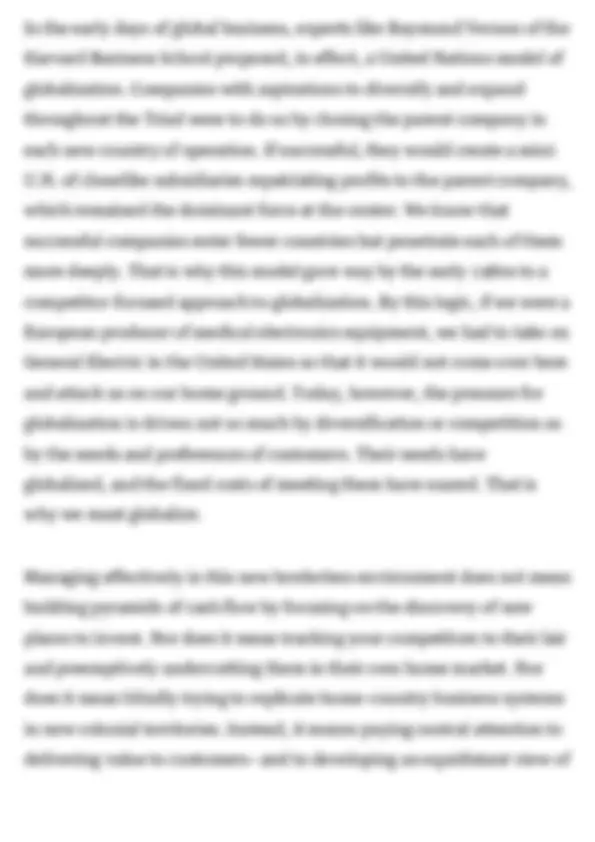



Study with the several resources on Docsity

Earn points by helping other students or get them with a premium plan


Prepare for your exams
Study with the several resources on Docsity

Earn points to download
Earn points by helping other students or get them with a premium plan
Community
Ask the community for help and clear up your study doubts
Discover the best universities in your country according to Docsity users
Free resources
Download our free guides on studying techniques, anxiety management strategies, and thesis advice from Docsity tutors
INTERNATIONAL BUSINESS. Managing in a. Borderless World by Kenichi Ohmae. FROM THE MAY–JUNE 1989 ISSUE. Most managers are nearsighted. Even though today's.
Typology: Summaries
1 / 27

This page cannot be seen from the preview
Don't miss anything!




















INTERNATIONAL BUSINESS
FROM THE MAY–JUNE 1989 ISSUE
ost managers are nearsighted. Even though today’s competitive landscape often stretches to a global horizon, they see best what they know best: the customers geographically closest to home. These managers may have factories or laboratories in a dozen countries. They may have joint ventures in a dozen more. They may source materials and sell in markets all over the world. But when push comes to shove, their field of vision is dominated by home-country customers and the organizational units that serve them. Everyone—and everything—else is simply part of “the rest of the world.” This nearsightedness is not intentional. No responsible manager purposefully devises or implements an astigmatic strategy. But by the same token, too few managers consciously try to set plans and build
organizations as if they saw all key customers equidistant from the corporate center. Whatever the trade figures show, home markets are usually in focus; overseas markets are not. Effective global operations require a genuine equidistance of perspective. But even with the best will in the world, managers find that kind of vision hard to develop—and harder to maintain. Not long ago, the CEO of a major Japanese capital-goods producer canceled several important meetings to attend the funeral of one of his company’s local dealers. When I asked him if he would have done the same for a Belgian dealer, one who did a larger volume of business each year than his late counterpart in Japan, the unequivocal answer was no. Perhaps headquarters would have had the relevant European manager send a letter of condolence. No more than that. In Japan, however, tradition dictated the CEO’s presence. But Japanese tradition isn’t everything, I reminded him. After all, he was the head of a global, not just a Japanese organization. By violating the principle of equidistance, his attendance underscored distinctions among dealers. He was sending the wrong signals and reinforcing the wrong values. Poor vision has consequences. It may be unfamiliar and awkward, but the primary rule of equidistance is to see—and to think—global first. Honda, for example, has manufacturing divisions in Japan, North America, and Europe—all three legs of the Triad—but its managers do not think or act as if the company were divided between Japanese and overseas operations. Indeed, the very word “overseas” has no place in Honda’s vocabulary because the
countries, the styles of clothing now in fashion, the sports, the lifestyles. In Japan, for example, our leaders can no longer keep the people in substandard housing because we now know—directly—how people elsewhere live. We now travel abroad. In fact, ten million Japanese travel abroad annually these days. Or we can sit in our living rooms at home, watch CNN, and know instantaneously what is happening in the United States. During 1988 , nearly 90 % of all Japanese honeymooners went abroad. This kind of fact is hard to ignore. The government now seriously recognizes that it has built plants and offices but has failed to meet the needs of its young people for relaxation and recreation. So, for the first time in 2 , 000 years, our people are revolting against their government and telling it what it must do for them. This would have been unthinkable when only a small, official elite controlled access to all information. In the past, there were gross inefficiencies—some purposeful, some not —in the flow of information around the world. New technologies are eliminating those inefficiencies, and, with them, the opportunity for a kind of top-down information arbitrage—that is, the ability of a government to benefit itself or powerful special interests at the expense of its people by following policies that would never win their support if they had unfettered access to all relevant information. A government could, for example, protect weak industries for fear of provoking social unrest over unemployment. That is less easy to do now, for more of its people have become cosmopolitan and have their own sources of information. They know what such a policy would cost them.
In Korea, students demonstrate in front of the American embassy because the government allows the United States to export cigarettes to Korea and thus threaten local farmers. That’s what happens when per capita GNP runs in the neighborhood of $ 5 , 000 a year and governments can still control the flow of information and mislead their people. When GNP gets up to around $ 10 , 000 a year, religion becomes a declining industry. So does government. At $ 26 , 000 a year, where Japan is now, things are really different. People want to buy the best and the cheapest products—no matter where in the world they are produced. People become genuinely global consumers. We import beef and oranges from the United States, and everyone thinks it’s great. Ten years ago, however, our students would have been the ones throwing stones at the American embassy. Our leaders used to tell us American and Australian beef was too lean and too tough to chew. But we’ve been there and tasted it and know for ourselves that it is cheap and good. Through this flow of information, we’ve become global citizens, and so must the companies that want to sell us things. Black-and-white television sets extensively penetrated households in the United States nearly a dozen years before they reached comparable numbers of viewers in Europe and Japan. With color television, the time lag fell to about five or six years for Japan and a few more for Europe. With videocassette recorders, the difference was only three or four years—but this time, Europe and Japan led the way; the United States, with its
working the next day with few hesitations or problems. They will find equipment with which they are familiar, equipment they have used before, equipment that comes from the same manufacturers. The drug companies are not alone in this. Most people, for example, believed that it would be a very long time before Korean companies could produce state-of-the-art semiconductor chips—things like 256 K NMOS DRAMs. Not so. They caught up with the rest of the Triad in only a few short years. In Japan, not that long ago, a common joke among the chip-making fraternity had to do with the “Friday Express.” The Japanese engineers working for different companies on Kyushu, Japan’s southwestern “Silicon Island” only 100 km or so away from Korea, would catch a late flight to Korea on Friday evenings. During the weekend, they would work privately for Korean semiconductor companies. This was illegal, of course, and violated the engineers’ employment agreements in Japan. Nonetheless, so many took the flight that they had a tacit gentleman’s agreement not to greet or openly recognize each other on the plane. Their trip would have made no sense, however, if semiconductor-related machines, methods, software, and workstations had not already become quite similar throughout the developed world. Walk into a capital-goods factory anywhere in the developed world, and you will find the same welding machines, the same robots, the same machine tools. When information flows with relative freedom, the old geographic barriers become irrelevant. Global needs lead to global
products. For managers, this universal flow of information puts a high premium on learning how to build the strategies and the organizations capable of meeting the requirements of a borderless world. What Is a Universal Product? Imagine that you are the CEO of a major automobile company reviewing your product plans for the years ahead. Your market data tell you that you will have to develop four dozen different models if you want to design separate cars for each distinct segment of the Triad market. But you don’t have enough world-class engineers to design so many models. You don’t have enough managerial talent or enough money. No one does. Worse, there is no single “global” car that will solve your problems for you. America, Europe, and Japan are quite different markets with quite different mixes of needs and preferences. Worse still, as head of a worldwide company, you cannot write off any of these Triad markets. You simply have to be in each of them—and with first- rate successful products. What do you do? If you are the CEO of Nissan, you first look at the Triad region by region and identify each market’s dominant requirements. In the United Kingdom, for example, tax policies make it essential that you develop a car suitable for corporate fleet sales. In the United States, you need a sporty “Z” model as well as a four-wheel drive family vehicle. Each of these categories is what Nissan’s president, Yutaka Kume, calls a “lead country” model—a product carefully tailored to the dominant and distinct needs of individual national markets. Once you have your short
They like what they like, not some mathematical compromise. Kume is emphatic about this particular point. “Our success in the U.S. with Maxima, 240 SX, and Pathfinder—all designed for the American market —shows our approach to be right.” In high school physics, I remember learning about a phenomenon called diminishing primaries. If you mix together the primary colors of red, blue, and yellow, what you get is black. If Europe says its consumers want a product in green, let them have it. If Japan says red, let them have red. No one wants the average. No one wants the colors all mixed together. Of course it makes sense to take advantage of, say, any technological commonalities in creating the paint. But local managers close to local customers have to be able to pick the color. When it comes to product strategy, managing in a borderless world doesn’t mean managing by averages. It doesn’t mean that all tastes run together into one amorphous mass of universal appeal. And it doesn’t mean that the appeal of operating globally removes the obligation to localize products. The lure of a universal product is a false allure. The truth is a bit more subtle. Although the needs and tastes of the Triad markets vary considerably, there may well be market segments of different sizes in each part of the Triad that share many of the same preferences. In the hair-care market, for instance, Japanese companies know a lot more about certain kinds of black hair, which is hard and thick, than about blond or brown hair,
which is often soft and thin. As a result, they have been able to capture a few segments of the U.S. market in, say, shampoos. That makes a nice addition to their sales, of course. But it does not position them to make inroads into the mainstream segments of that market. Back to the automobile example: there is a small but identifiable group of Japanese consumers who want a “Z” model car like the one much in demand in the United States. Fair enough. During the peak season, Nissan sells about 5 , 000 “Z” cars a month in the United States and only 500 in Japan. Those 500 cars make a nice addition, of course, generating additional revenue and expanding the perceived richness of a local dealer’s portfolio. But they are not—and cannot be—the mainstay of such portfolios. There is no universal “montage” car—a rear axle from Japan, a braking system from Italy, a drive train from the United States—that will quicken pulses on all continents. Remember the way the tabloids used to cover major beauty contests? They would create a composite picture using the best features from all of the most beautiful entrants—this one’s nose, that one’s mouth, the other one’s forehead. Ironically, the portrait that emerged was never very appealing. It always seemed odd, a bit off, lacking in distinctive character. But there will always be beauty judges— and car buyers—in, say, Europe, who, though more used to continental standards, find a special attractiveness in the features of a Japanese or a Latin American. Again, so much the better.
Another important cluster of these global products is made up of fashion-oriented, premium-priced branded goods. Gucci bags are sold around the world, unchanged from one place to another. They are marketed in virtually the same way. They appeal to an upper bracket market segment that shares a consistent set of tastes and preferences. By definition, not everyone in the United States or Europe or Japan belongs to that segment. But for those who do, the growing commonality of their tastes qualifies them as members of a genuinely cross-Triad, global segment. There is even such a segment for top-of- the-line automobiles like the Rolls-Royce and the Mercedes-Benz. You can—in fact, should—design such cars for select buyers around the globe. But you cannot do that with Nissans or Toyotas or Hondas. Truly universal products are few and far between. Insiderization Some may argue that my definition of universal products is unnecessarily narrow, that many such products exist that do not fit neatly into top-bracket segments: Coca-Cola, Levi’s, things like that. On closer examination, however, these turn out to be very different sorts of things. Think about Coca-Cola for a moment. Before it got established in each of its markets, the company had to build up a fairly complete local infrastructure and do the groundwork to establish local demand. Access to markets was by no means assured from day one; consumer preference was not assured from day one. In Japan, the long-established preference was for carbonated lemon drinks known as saida. Unlike
Gucci bags, consumer demand did not “pull” Coke into these markets; the company had to establish the infrastructure to “push” it. Today, because the company has done its homework and done it well, Coke is a universally desired brand. But it got there by a different route: local replication of an entire business system in every important market over a long period of time. For Gucci-like products, the ready flow of information around the world stimulates consistent primary demand in top-bracket segments. For relatively undifferentiated, commodity-like products, demand expands only when corporate muscle pushes hard. If Coke is to establish a preference, it has to build it, piece by piece. Perhaps the best way to distinguish these two kinds of global products is to think of yourself browsing in a duty-free shop. Here you are in something of an oasis. National barriers to entry do not apply. Products from all over the world lie available to you on the shelves. What do you reach for? Do you think about climbing on board your jetliner with a newly purchased six-pack of Coke? Hardly. But what about a Gucci bag? Yes, of course. In a sense, duty-free shops are the precursor to what life will be like in a genuinely borderless environment. Customer pull, shaped by images and information from around the world, determine your product choices. You want the designer handbag or the sneakers by Reebok, which are made in Korea and sold at three times the price of equivalent no-brand sneakers. And there are others like you in every corner of the Triad.
Coke has 70 % of the Japanese market for soft drinks. The reason is that Coke took the time and made the investments to build up a full range of local functional strengths, particularly in its route sales force and franchised vending machines. It is, after all, the Coke van or truck that replaces empty bottles with new ones, not the trucks of independent wholesalers or distributors. When Coke first moved into Japan, it did not understand the complex, many-layered distribution system for such products. So it used the capital of local bottlers to re-create the kind of sales force it has used so well in the United States. This represented a heavy, front-end, fixed investment, but it has paid off handsomely. Coke redefined the domestic game in Japan—and it did so, not from a distance, but with a deliberate “insiderization” of functional strengths. Once this sales force is in place, for example, once the company has become a full-fledged insider, it can move not only soft drinks but also fruit juice, sport drinks, vitamin drinks, and canned coffee through the same sales network. It can sell pretty much whatever it wants to. For Coke’s competitors, foreign and domestic, the millions of dollars they are spending on advertising are like little droplets of water sprinkled over a desert. Nothing is going to bloom—at least, not if that is all they do. Not if they fail to build up their own distinctive “insider” strengths. When global success rests on market-by-market functional strength, you have to play a series of domestic games against well-defined competitors. If the market requires a first-class sales force, you simply have to have one. If competition turns on dealer support programs, that’s where you have to excel. Some occasions do exist when doing
more better is the right, the necessary, course to follow. Still, there are usually opportunities to redefine these domestic games to your own advantage. Companies that fail to establish a strong insider position tend to mix up the strategies followed by the Cokes and the Guccis. The managers of many leading branded-goods companies are often loud in their complaints about how the Japanese market is closed to their products. Or, more mysteriously, about the inexplicable refusal of Japanese consumers to buy their products when they are obviously better than those of any competitor anywhere in the world. Instead of making the effort to understand Japanese distribution and Japanese consumers, they assume that something is wrong with the Japanese market. Instead of spending time in their plants and offices or on the ground in Japan, they spend time in Washington. Not everyone, of course. There are plenty of branded-goods companies that are very well represented on the Japanese retailing scene—Coke, to be sure, but also Nestlé, Schick, Wella, Vicks, Scott, Del Monte, Kraft, Campbell, Unilever (its Timotei shampoo is number one in Japan), Twinings, Kellogg, Borden, Ragu’, Oscar Mayer, Hershey, and a host of others. These have all become household names in Japan. They have all become insiders. For industrial products companies, becoming an insider often poses a different set of challenges. Because these products are chosen largely on the basis of their performance characteristics, if they cut costs or boost productivity, they stand a fair chance of being accepted anywhere in the
By all reasonable measures, Coke’s experience in Japan has been a happy one. More often than not, however, the path it took to insiderization—replicating a home-country business system in a new national market—creates many more problems than it solves. Managers back at headquarters, who have had experience with only one way to succeed, are commonly inclined to force that model on each new opportunity that arises. Of course, sometimes it will work. Sometimes it will be exactly the right answer. But chances are that the home-country reflex, the impulse to generalize globally from a sample of one, will lead efforts astray. In the pharmaceutical industry, for example, Coke’s approach would not work. Foreign entrants simply have to find ways to adapt to the Japanese distribution system. Local doctors will not accept or respond favorably to an American-style sales force. When the doctor asks a local detail man to take a moment and photocopy some articles for him, he has to be willing to run the errands. No ifs, ands, or buts. One common problem with insiderization, then, is a misplaced home- country reflex. Another, perhaps more subtle, problem is what happens back at headquarters after initial operations in another market really start paying off. When this happens, in most companies everyone at home starts to pay close attention. Without really understanding why things have turned out as well as they have, managers at headquarters take an increasing interest in what is going on in Japan or wherever it happens to be.
Functionaries of all stripes itch to intervene. Corporate heavyweights decide they had better get into the act, monitor key decisions, ask for timely reports, take extensive tours of local activities. Every power-that- be wants a say in what has become a critical portion of the overall company’s operations. When minor difficulties arise, no one is willing to let local managers continue to handle things themselves. Corporate jets fill the skies with impatient satraps eager to set things right. We know perfectly well where all this is likely to lead. A cosmetics company, with a once enviable position in Japan, went through a series of management shake-ups at home. As a result, the Japanese operation, which had grown progressively more important, was no longer able to enjoy the rough autonomy that made its success possible. Several times, eager U.S. hands reached in to change the head of activities in Japan, and crisp memos and phone calls kept up a steady barrage of challenges to the unlucky soul who happened to be in the hot seat at the moment. Relations became antagonistic, profits fell, the intervention grew worse, and the whole thing just fell apart. Overeager and overanxious managers back at headquarters did not have the patience to learn what really worked in the Japanese market. By trying to supervise things in the regular “corporate” fashion, they destroyed a very profitable business. This is an all-too-familiar pattern. With dizzying regularity, the local top manager changes from a Japanese national to a foreigner, to a Japanese, to a foreigner. Impatient, headquarters keeps fitfully searching for a